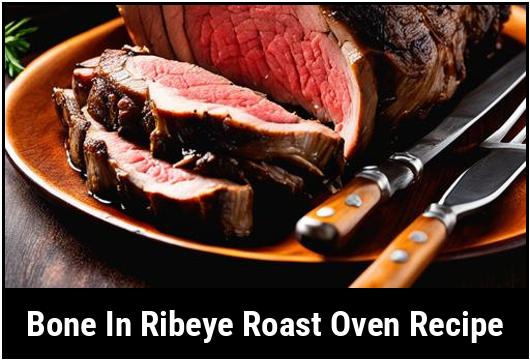
The Perfect Bone-In Ribeye Roast Oven Recipe: A Culinary Delight
Welcome to the world of culinary excellence and gastronomy! In this extensive article, we will delve into the art of preparing a mouthwatering bone-in ribeye roast in your trusty oven. Whether it’s for a festive occasion, a family gathering, or simply a treat for yourself, this recipe is guaranteed to impress. Join us as we explore the food science, culinary details, selection process, cleaning, preparation, useful tips, scrumptiously unique variations, doneness checks, and everything you need to know to ensure a perfectly cooked bone-in ribeye roast!
Understanding the Food Science
Before we dive into the nitty-gritty of preparing the perfect bone-in ribeye roast, let’s take a moment to understand the science behind this culinary masterpiece. A bone-in ribeye roast is known for its rich marbling, exquisite tenderness, and exceptional flavor. The bone adds an extra element, enhancing taste and promoting even cooking. Whether you opt for the less expensive chuck roast or indulge in a premium prime rib cut, the quality of the meat directly affects the final result.
The marbling in a ribeye roast consists of intramuscular fat that melts during the cooking process, resulting in a juicy, succulent texture. This is complemented by the bone, which acts as a conductor of heat, aiding in uniform cooking. Understanding these elements allows us to appreciate the potential and uniqueness of the bone-in ribeye roast.
Selecting Your Ribeye Roast
To create a remarkable bone-in ribeye roast, you must start with a top-quality cut of beef. When it comes to selecting the perfect roast, certain factors come into play. Look for a well-marbled roast with a good fat cap, as this will ensure a moist, tender, and flavorful outcome. It’s best to choose a roast that weighs between 5-7 pounds, as smaller cuts tend to dry out more easily.
Cleaning the Roast
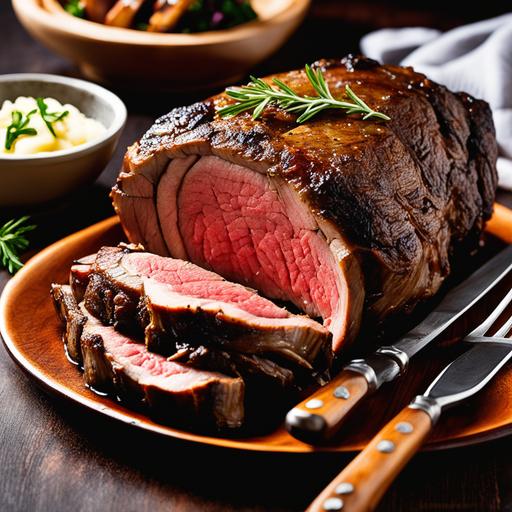
Before we get our hands into the preparation process, it’s essential to clean the ribeye roast properly. Start by removing any excess packaging, such as plastic or butcher paper. Rinse the roast thoroughly under cold running water to remove any bone fragments or loose debris that may have collected during its journey from the butcher’s counter to your kitchen. Pat the roast dry gently using a paper towel, ensuring the meat is moisture-free.
Preparation Tips
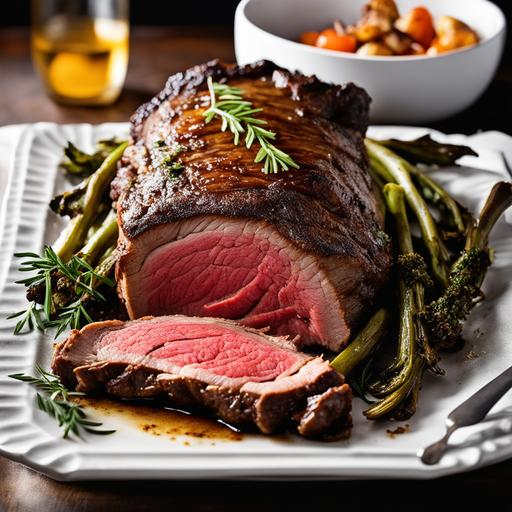
Now that your bone-in ribeye roast is clean and ready, let’s move on to the preparation stage. Here are a few expert tips to help you create a culinary masterpiece:
-
Allow for Dry Aging: Dry aging the roast, if time permits, can enhance the flavor and tenderness. Simply place the roast uncovered on a rack in the refrigerator for 1-3 days, allowing the surface to dry out.
-
Seasoning: Before cooking, it’s crucial to season the roast generously. A classic combination of kosher salt, coarse black pepper, and minced garlic is an excellent foundation. Feel free to add your favorite herbs and spices to suit your personal preference.
-
Resting Period: Letting the seasoned roast stand at room temperature for at least 1 hour before cooking allows the flavors to meld and the meat to come to an even temperature.
Cooking Variations
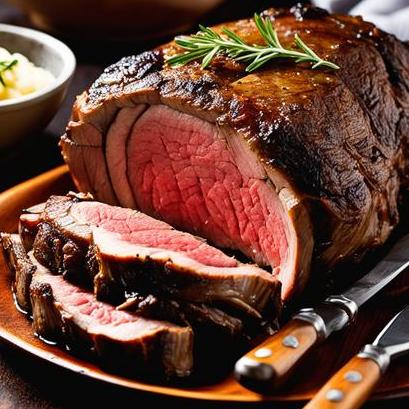
There are two popular cooking methods for bone-in ribeye roasts: searing then roasting and reverse searing. Let’s explore these techniques:
-
Searing then Roasting: This traditional method involves searing the roast in a hot skillet for a few minutes per side, creating a flavorful crust. After searing, transfer the roast to a preheated oven and continue cooking until reaching the desired internal temperature. This method produces a beautifully caramelized exterior and an evenly cooked interior.
-
Reverse Searing: The reverse sear method flips the conventional cooking process. Begin by slow roasting the ribeye at a low temperature (275-300°F) until it reaches approximately 10-15°F below your desired final internal temperature. Once the ideal temperature is reached, remove the roast from the oven and let it rest. Just before serving, sear the roast on a hot skillet or grill for a few minutes per side, creating a fantastic crust while preserving the juicy interior.
Checking for Doneness
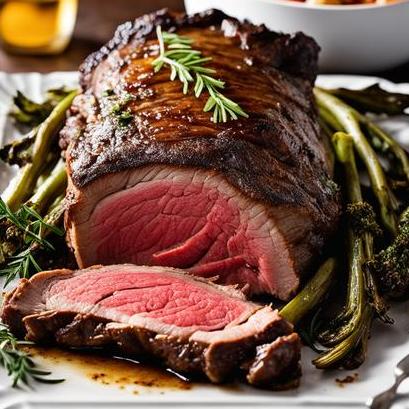
Achieving the perfect doneness is crucial to ensure a mouthwatering bone-in ribeye roast experience. The internal temperature serves as a reliable indicator. Utilize a meat thermometer to determine the roast’s temperature without the need for guesswork. Here are some temperature guidelines to consider:
-
Rare: 120-125°F
-
Medium Rare: 130-135°F
-
Medium: 140-145°F
-
Medium Well: 150-155°F
-
Well Done: 160°F and above
For enhanced accuracy, insert the thermometer into the center of the roast, ensuring the tip does not touch the bone. Remember, the roast’s temperature will continue to rise a few more degrees while resting, so adjust accordingly.
Recipe: The Ultimate Bone-In Ribeye Roast
Are you ready to transform your bone-in ribeye roast into an unforgettable culinary adventure? Here’s our tried and tested recipe:
Ingredients:
-
1 bone-in ribeye roast (5-7 pounds)
-
4 tablespoons kosher salt
-
2 tablespoons coarse black pepper
-
4 cloves garlic, minced
-
Optional: Your favorite herbs and spices (thyme, rosemary, etc.)
Instructions:
-
Preheat your oven to 450°F.
-
In a small bowl, mix the kosher salt, coarse black pepper, minced garlic, and any additional herbs or spices you desire.
-
Generously rub the seasoning mixture onto all sides of the ribeye roast. Ensure an even distribution, gently pressing the seasoning into the meat to promote flavor absorption.
-
Place the roast on a wire rack set over a baking sheet to allow air circulation.
-
Insert a meat thermometer into the center of the roast, ensuring it does not touch the bone.
-
Place the ribeye roast in the preheated oven and roast for approximately 15 minutes or until a beautiful crust forms.
-
Reduce the oven temperature to 325°F and continue cooking until the internal temperature on the meat thermometer reaches your desired level of doneness (see temperature guidelines).
-
Once the ideal temperature is reached, remove the roast from the oven and cover it loosely with aluminum foil. Allow it to rest for 20-30 minutes to maximize juiciness.
-
After resting, remove the foil and carve the ribeye roast into succulent slices. Serve with your favorite sides and enjoy the flavorsome masterpiece you’ve created!
Overcooking and Undercooking: Rescuing the Meat
No matter how experienced a chef you are, there can always be mishaps in the kitchen. Should you find yourself with an overcooked or undercooked bone-in ribeye roast, fear not! There are ways to salvage the situation:
-
Overcooked: If you accidentally overcook your roast, it may become tougher and drier. However, all is not lost! Try slicing the meat thinly against the grain and bathing the slices in a delicious au jus or beef broth to add moisture. Alternatively, thinly slicing the overcooked roast for sandwiches or using it in stir-fries can also help salvage the flavors.
-
Undercooked: In the unfortunate event of undercooked meat, you can easily rectify the situation by returning the roast to the oven at a moderate temperature until reaching the desired level of doneness. Ensure you keep a close eye on the internal temperature using a meat thermometer for accurate results.
Conclusion
Preparing a bone-in ribeye roast oven recipe is an elaborate yet rewarding journey into the realm of culinary pleasure. We hope this comprehensive guide has provided you with the knowledge and confidence to embark upon your own ribeye roast adventure. Remember to choose a well-marbled, bone-in roast, clean and season it meticulously, and cook it to perfection. By following these steps and incorporating your own personal touch, you’re bound to impress yourself and those lucky enough to enjoy the final creation. Happy cooking and bon appétit!
Sources
FAQS On Bone In Ribeye Roast Oven Recipe
What Is A Bone-in Ribeye Roast?
A bone-in ribeye roast is a cut of beef from the rib primal that includes the rib bones and surrounding meat. It is typically a large cut of meat that can weigh anywhere from 4 to 8 pounds.
How Do I Prepare A Bone-in Ribeye Roast For Cooking?
The first step in preparing a bone-in ribeye roast is to take it out of the fridge and let it sit at room temperature for 30 minutes to an hour. This will help the roast cook more evenly. Then, season the roast with your choice of herbs, spices, and salt. You can also marinate the roast overnight for added flavor.
What Is The Recommended Cooking Method For A Bone-in Ribeye Roast?
The most popular method for cooking a bone-in ribeye roast is in the oven. Preheat your oven to 450°F and place the roast in a roasting pan with the bones facing up. For medium-rare, cook for 20 minutes per pound. For medium, cook for 25 minutes per pound. For well-done, cook for 30 minutes per pound.
How Can I Ensure That My Bone-in Ribeye Roast Is Cooked To The Desired Level Of Doneness?
The best way to ensure that your bone-in ribeye roast is cooked to your preferred doneness is by using a meat thermometer. For medium-rare, the internal temperature should be 135°F, for medium it should be 145°F, and for well-done it should be 160°F.
How Long Should I Let The Bone-in Ribeye Roast Rest Before Slicing And Serving?
It is important to let the bone-in ribeye roast rest for at least 15 minutes after cooking. This allows the juices to redistribute and results in a more tender and flavorful roast. Tent the roast with foil while it rests to keep it warm.



